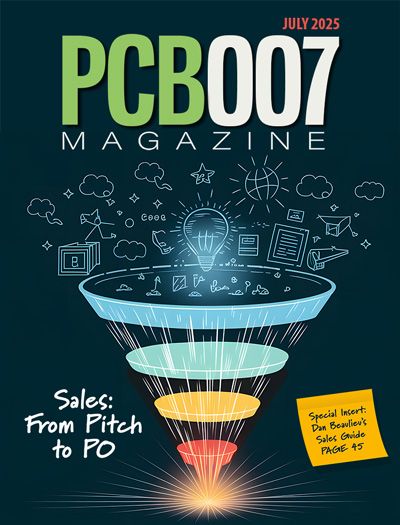-

-
News
News Highlights
- Books
Featured Books
- pcb007 Magazine
Latest Issues
Current Issue
Advancing the Advanced Materials Discussion
Moore’s Law is no more, and the advanced material solutions to grapple with this reality are surprising, stunning, and perhaps a bit daunting. Buckle up for a dive into advanced materials and a glimpse into the next chapters of electronics manufacturing.

Inventing the Future With SEL
Two years after launching its state-of-the-art PCB facility, SEL shares lessons in vision, execution, and innovation, plus insights from industry icons and technology leaders shaping the future of PCB fabrication.

Sales: From Pitch to PO
From the first cold call to finally receiving that first purchase order, the July PCB007 Magazine breaks down some critical parts of the sales stack. To up your sales game, read on!
- Articles
- Columns
- Links
- Media kit
||| MENU - pcb007 Magazine
Why are Flexible Computer Screens Taking so Long to Develop?
January 21, 2016 | University of CambridgeEstimated reading time: 3 minutes
Stuart Higgins (Cavendish Laboratory) discusses the technology being developed to create flexible displays.
It’s common to first see exciting new technologies in science fiction, but less so in stories about wizards and dragons. Yet one of the most interesting bits of kit on display at this year’s Consumer Electronics Show (CES) in Las Vegas was reminiscent of the magical Daily Prophet newspaper in the Harry Potter series.
Thin, flexible screens such as the one showcased by LG could allow the creation of newspapers that change daily, display video like a tablet computer, but that can still be rolled up and put in your pocket. These plastic electronic displays could also provide smartphones with shatterproof displays (good news for anyone who’s inadvertently tried drop-testing their phone onto the pavement) and lead to the next generation of flexible wearable technology.
But LG’s announcement is not the first time that flexible displays has been demonstrated at CES. We’ve seen similar technologies every year for some time now, and LG itself unveiled another prototype in a press release 18 months ago. Yet only a handful of products have come to market that feature flexible displays, and those have the displays mounted in a rigid holder, rather than free for the user to bend. So why is this technology taking so long to reach our homes?
How displays work
Take a look at your computer screen through a magnifying glass and you’ll see the individual pixels, each made up of three subpixels – red, green, and blue light sources. Each of these subpixels is connected via a grid of wires that criss-cross the back of the display to another circuit called a display driver. This translates incoming video data into signals that turn each subpixel on and off.
How each pixel generates light varies depending on the technology used. Two of the most common seen today are liquid crystal displays (LCDs) and organic light emitting diodes (OLEDs). LCDs use a white light at the back of the display that passes through red, green and blue colour filters. Each subpixel uses a combination of liquid crystals and polarising filters that act like tiny shutters, either letting light through or blocking it.
OLEDs, on the other hand, are mini light sources that directly generate light when turned on. This removes the need for the white light behind the display, reducing its overall thickness, and is one of the driving factors behind the growing uptake of OLED technology.
Page 1 of 2
Testimonial
"Advertising in PCB007 Magazine has been a great way to showcase our bare board testers to the right audience. The I-Connect007 team makes the process smooth and professional. We’re proud to be featured in such a trusted publication."
Klaus Koziol - atgSuggested Items
SAMI Advanced Electronics Company Launches “Remal” Computer Manufacturing Project in Partnership with HP and Foxconn
10/15/2025 | SAMI-AECSAMI Advanced Electronics Company (SAMI-AEC), a wholly owned subsidiary of Saudi Arabian Military Industries (SAMI), proudly announced the launch of the “Remal” project for computer manufacturing, in strategic partnership with HP and Foxconn.
The Right Approach: Electro-Tek—A Williams Family Legacy, Part 1
10/15/2025 | Steve Williams -- Column: The Right ApproachThere is no bronze bust in the lobby or portrait in the conference room of Electro-Tek's founder—my Dad, Charles “Chuck” Williams—so with the facility closing last year after 56 years, I feel it is time to tell the story. Chuck Williams founded Electro-Tek in 1968 in our basement, eventually moving into the second floor of an old 1913 building in downtown Milwaukee that is still standing (the first of three eventual facilities).
LPKF Joins productronica’s 50th Anniversary, Showcasing Laser Technology for Electronics Manufacturing
10/10/2025 | LPKF Laser & ElectronicsLPKF Laser & Electronics invites visitors to productronica 2025 in Munich from November 18 to 21. At booth 305 in hall B2, the company will present its portfolio of modern laser technologies for the electronics industry live – from prototyping systems and high-performance depaneling to laser plastic welding for electronic housings and thin glass processing for advanced packaging.
Marco Pieters Appointed ASML Chief Technology Officer
10/09/2025 | ASMLASML Holding NV (ASML) announced the appointment of Marco Pieters as Executive Vice President and Chief Technology Officer, reporting to President and Chief Executive Officer, Christophe Fouquet.
Advanced Rework Technology Inspires Students at National Manufacturing Day 2025
10/08/2025 | A.R.T. Ltd.Advanced Rework Technology Ltd. (A.R.T.), a leading independent IPC-accredited training provider, joined forces with Jaltek, a UK-based electronics manufacturer with over 35 years’ experience in designing and producing high-quality electronic products, to deliver hands-on workshops for students during National Manufacturing Day 2025.


